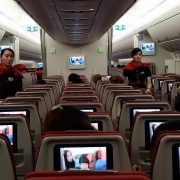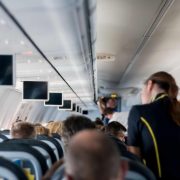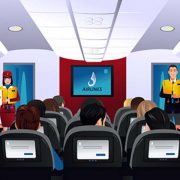Commuting flight attendants and luggage
How many bags can a commuting flight attendant bring with them on board an aircraft? Does it matter if the flight attendant is in uniform or not?
The topic of commuting flight attendants and the amount of luggage they can bring is not explicitly addressed by regulation, advisory circular, or other guidance. Yet the answer is within how the applicable regulation is structured.
To begin, we’ll look at the regulation, 14 CFR 121.589 Carry‐on baggage. In regulations, certain words make the application of the regulation very specific.
- Certificate holder = the airline;
- No person = anyone;
- Passenger(s) = passengers;
- Person = an/the individual.
In 121.589 (a), it says, “(a) No certificate holder may allow the boarding of carry‐on baggage on an airplane unless each passenger’s baggage has been scanned to control the size and amount carried on board in accordance with an approved carry‐on baggage program in its operations specifications. In addition, no passenger may board an airplane if his/her carry‐on baggage exceeds the baggage allowance prescribed in the carry‐on baggage program in the certificate holder’s operations specifications.
From what’s written and highlighted in bold, no airline can allow any passenger to bring bags on if they exceed a certain size or quantity as found in their approved Carry‐On Baggage (COB) program. So, here’s where it can become complicated. Here is how I understand the regulations and policy, based upon what’s written and using reasonable judgment. For the different possibilities, I’d say it depends on what is happening, and when.
In 14 CFR 1.1 General Definitions, the definition of Crewmember: Crewmember means a person assigned to perform duty in an aircraft during flight time. In 14 CFR 110.2 Definitions, there are definitions that do specify passenger and crewmember and certain inclusions and exclusions with regard to seats.
For example, crewmember seats do not count towards the total number of passenger seats installed on an aircraft. While crewmembers and passengers are categorized differently than each other, the application of terms depends upon the capacity they are in at that moment in time. Ultimately, when any person is on board an aircraft, they are either a crewmember or a passenger. The definition of a crewmember is specific, “assigned to perform duty in an aircraft during flight time.” Simply, either a person is working that flight or they are not.
So, to reasonably apply the regulation with regard to the operation and possibly start or end of work status:
Out of uniform during commute: A crewmember out of uniform is either commuting to a base and not immediately operating a flight, or commuting home. In this instance, it would be reasonable to apply the COB program rules to the crewmember as a passenger as there is no work‐related urgency connected to the commute. The airline may require bags to be checked to comply with the COB program limits.
In uniform, it may depend upon whether the person is commuting into a live-work assignment, or commuting home after completion of their duty assignment.
- Commuting to a live-work assignment, although technically the commuting employee is defined as a passenger since they are commuting, the airline may elect to accommodate additional bags outside the COB program to prevent undue delay to the operation. This would technically be non‐compliance with the COB program, however, it may be viewed as an operational necessity. Bags sent to baggage claim may potentially cause an operational delay if the airline does not provide baggage gate check and retrieval for employees. However, the airline would be within their right and compliance with the COB if they gate checked additional bags into the cargo compartment and delivered them at the arrival luggage carousel.
- Commuting home after a duty assignment or on a day off, although in uniform, the employee is now a passenger, subject to the COB program. It would be most appropriate to apply the COB limits to the employee as they are not in crewmember status. Any exception to bring a third or fourth bag on board applied by the airline would be more of a courtesy, not an operational requirement. Technically, allowing excess baggage quantities outside the approved COB program would be contrary to the approved program, especially since there is no need or potential impact on the airline’s operation.
There is no regulatory requirement for an airline to ask what each commuting crewmember is doing, going to/from a work assignment. That would be a process for the airline to address and apply to their operation. For the purpose of COB program application or any regulation for that matter, excluding TSA, the uniform itself has no bearing on crewmember status. The operational status as set by the airline determines whether a person is a crewmember or not.
If an airline elects to treat all commuting flight attendants as passengers when not in crewmember status and fully apply the approved COB program, they are doing as required in compliance with the program. There may be inconsistencies within an airline’s system, for example, some stations allow commuting FAs to bring all bags onboard while other stations require bags to be checked. That would require internal clarification of policy and through internal communications, disseminate the policy to all station personnel and gate agents to achieve standardization across the system.
Commuting crewmembers are defined as passengers per definitions, and treated as such for the purpose of the Carry-on Baggage program.










Leave a Reply
Want to join the discussion?Feel free to contribute!